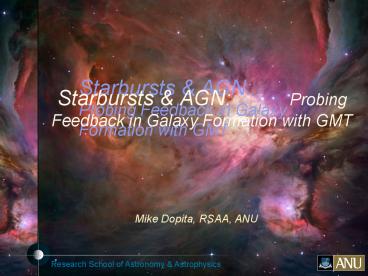Starbursts
1 / 24
Title: Starbursts
1
Starbursts AGN Probing Feedback in
Galaxy Formation with GMT
Starbursts AGN Probing Feedback in
Galaxy Formation with GMT
Mike Dopita, RSAA, ANU
2
Starburst Feedback at the Epoch of Galaxy
Formation
3
The Madau Plot Translated
Epoch of Assembly of Massive Galaxies 1 lt z lt 6
c.f. Papovich, Thursday..
4
Feedback from Massive Stars
- Controls the re-ionization of the Universe
- Determines the phase structure of the
Interstellar Medium - Triggers new star formation in starburst
environments - Controls the structural parameters of the disks
of galaxies - Produces galactic winds which enrich the
intergalactic medium
5
Condition to drive a Galactic Wind
- We need (at least) that the kinetic energy
injection per unit area into a fraction of the
disk gas will exceed its binding energy - Star formation follows the Kennicutt (1998) Law
- So a wind becomes possible when
- Therefore, a wind is driven when
- Escape Velocity is Low (i.e. galaxy is small)
- Lifetime of Starburst is long
- Gas surface density is high
6
Structure of a Superwind
Cooper, Bicknell Sutherland, RSAA astro-ph
0710.5437
7
Density Evolution
Cooper, Bicknell Sutherland, RSAA astro-ph
0710.5437
8
GMT Observations of Starburst-Powered
Protogalaxies
- Requires us to observe Lyman- break galaxies in
the range 6 gt z gt 2.5 (1.0 lt t/Gyr lt 2.7). - Star formation rates 50 - 500 solar masses /yr
- Sizes of objects 5 - 50 kpc.
- Resolution required 1 - 2 kpc (0.2 - 0.4 arc
sec.) - This is fine! - So, surface flux needed to see continuum 10-17
erg cm-2 arc sec-2 This is easily within the
range of the the GMT Optical (GMACS) and Near-IR
(NIRMOS) Multi-slit spectrographs. - We will be able to derive star formation rates
metallicities for hundreds of of these objects in
a single observing run.
9
The Sub-mm Galaxies Hot Dust, Extreme
Star Formation Rates
Low and Intermediate Redshift Sequence
High Redshift Sequence (sub-mm Galaxies)
from Blain, Chapman, Smail Ivison 2004, ApJ,
611, 52
10
Distant Radio Galaxies - Cores of
Protoclusters - AGN Driving the Transition to
Red-and-Dead Ellipticals
11
Distant Protoclusters
12
- Kurk, Pentericci, Röttgering, Miley Heckman
- Protocluster associated with radio galaxy at
z4.1. D 2 Mpc - Local over-density of galaxies 15
- M 1-2 x 1015 solar masses
13
O III Galaxies around Radio Galaxy MRC 0316-257
(z3.13)
CIII 1937Å
1513Å
1513Å
CIII 1937Å
CIII 1937Å
1513Å
ACS Observations, Box 2x2 arc sec. 16x16 kpc
Maschietto et al. 2008 MNRAS, submitted
14
Graphic from Huub Röttgering
15
AGN Feedback- Expelling the ISM- The
Transition to red-and-dead
16
Lyman-Alpha Halos around Radio Galaxies Massive
Galaxies in the Early Universe
17
Feedback by AGN Jet Interaction
18
Ly-Alpha Halos associated with Hi-z Radio
Galaxies are
- Luminous F 10-15 erg s-1 cm-2 or L 1044 erg
sec-1 - Large up to 200 kpc across or 20 arc sec in
diameter! - Over 400 candidates remain unstudied.
- Such galaxies (and their radio-quiet
counterparts) probably represent the dominant
mode of star formation in the Universe at 4 gt z gt
2
19
4C 41.17 is forming 5000 solar masses of stars
per year, but the emission line spectrum is
shock-powered
Dey et al 1997, ApJ 490, 698
20
Jet Hot-spot
Nucleus
Colour Ly-a Contours H-a
21
The Expanding Shell of 4C 60.07Evidence for AGN
Feedback
Ly-Alpha Halos associated with Hi-z Radio
Galaxies are
Reuland et al. 2006 AJ
22
Sphere of Influence of Black Hole (from Gemini
CoDR) - direct BH mass determination are just
out of reach of GMT
23
Summary of the Role of GMT in HizRG
Proto-cluster Studies
- Optical Multi-object spectrograph (GMACS)
Discover all the Ly-Alpha emitters in the
field, measure velocity dispersions, luminosities
clustering properties - Near-IR Multi-object spectrograph (NIRMOS)
Measure star formation rates from Balmer
Lines and metallicities from other lines. - Near-IR AO fed IFU (GMTIFS)
Determine star formation rates,
morphologies and velocity fields in both core of
radio galaxy and in associated field galaxies
24
The End































